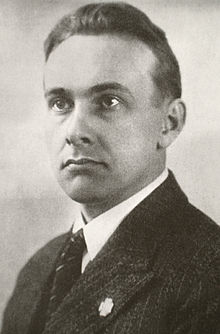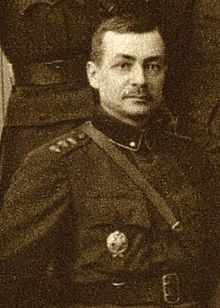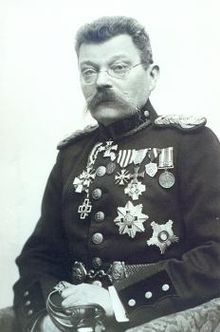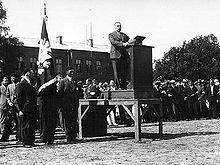Estonian Association of Freedom Fighters
The Estonian Association of Freedom Fighters ( Estonian Eesti Vabadussõjalaste Liit - EVL ; until 1933 Central Association of Estonian Freedom Fighters - EVKL ) was an anti-communist extra - parliamentary movement in Estonia during the interwar period .
The federal government was active from 1929 to the mid-1930s. He turned against parliamentarism and advocated a leadership state . The most charismatic personalities were its chairman General a. D. Andres Larka and the ideological thought leader and keynote speaker Artur Sirk . The members of the Federation were popularly called Vapsid or Vabsid .
prehistory
The Republic of Estonia declared its independence from Russia on February 24, 1918. In the following Estonian War of Freedom (1918-1920) she was able to militarily defend her independence and the democratic rule of law against Soviet Russia and the Bolsheviks .
Shortly after the end of the War of Independence, the " Association of Demobilized Soldiers of Estonia " ( Eesti Demobiliseeritud Sõjaväelaste Liit ) was founded in 1921 . It was a largely non-political interest organization that took care of the economic and political concerns of war veterans and recorded war memoirs. In addition, the patriotic "spirit of the war of freedom" should be passed on to the Estonian youth. In the mid-1920s, the general association dissolved, but continued to operate at the local level.
Central Association of Estonian Freedom Fighters (EVKL)

On the basis of the local associations of the veterans of Tallinn , Haapsalu and Tapa , the “Central Association of Estonian Freedom Fighters” ( Eesti Vabadussõjalaste Keskliit - EVKL ) was launched on June 2, 1929 . One of the main activists was the young Tallinn lawyer Artur Sirk (1900-1937), who had taken part in the war of freedom as a youth. Thanks to his rhetorical skills, Sirk quickly rose to become the undisputed leader of the EVKL.
I. Congress (1930)
The association was politically right-wing , but initially remained without clear political contours. Its aim was above all to represent the interests of war veterans and to provide national educational work for the youth, which should be based on a “sense of duty” and “national responsibility”. The EVKL strictly rejected Marxism or socialist ideas.
At the 1st Congress of the EVKL on January 26, 1930 in Tallinn, popular heroes of the War of Freedom such as the (retired) Generals Andres Larka (1879–1942) and Ernst Põdder (1879–1932) were elected as board members alongside Sirk .
II Congress (1931)


At the 2nd Congress of the EVKL on March 22, 1931 in Tallinn, economic and political questions came to the fore. Above all, the consequences of the global economic crisis , which hit Estonia hard, as well as the fragmentation of the Estonian party system with unstable and frequently changing governments, were criticized by the speakers. The crisis of the Estonian parliamentarism and measures to overcome it became a major issue.
The EVKL quickly became politicized on the right, extra-parliamentary fringes. In addition to Sirk and Larka, Colonel Aleksander Seiman (1886–1941) and the Baltic German baron Peter Eugen Arthur von Buxhoeveden (1882–1964) also had a strong influence on the association . Then there was the right-wing former Interior Minister Theodor Rõuk , who had been Sirk's mentor for a long time. Rõuk advocated changing the Estonian constitution away from a parliamentary to a presidential system of government . The call for a "strong man in the state" employed by divided and allegedly corrupt political parties became louder and louder within the EVKL.
The leadership team briefly included the headstrong but popular Admiral Johan Pitka (1872-1944), who had suffered shipwreck in his short-lived National Liberal Party ( Rahvuslik-Vabameelne Party ) in the mid-20s . He was elected deputy chairman of the EVKL in 1931. A year later he resigned from the movement after violent arguments with Larka and Sirk.
Võitlus ("The Struggle"), the official press organ of the EVKL, now intensified the domestic political tone against the Estonian parties and parliamentary democracy. As an extra-parliamentary opposition, the EVKL found more and more ideal supporters who were tired of the party quarrels and the deficits of parliamentarism. Above all, members of the lower middle class in the cities increasingly joined the ideas of the EVKL. In addition, the association carried out successful lobbying work in influential economic and social circles against the existing political system.
III. Congress (1932)
The III. The EVKL congress on March 20, 1932 in Tallinn brought about further political radicalization. The EVKL now opened up to male and female members who had not participated in the Estonian War of Freedom. It thus became an extra-parliamentary catchment basin for numerous dissatisfied people in the political system, above all those who lost out in the global economic crisis and those who were disappointed in democratic development since 1920.
In particular, new, younger members contributed to a radicalization of the positions, which Sirk cleverly took up. In addition, there was the instruction of the Estonian government that active military personnel must withdraw from the leadership positions of the EVKL and its local organizations; more moderate voices from Estonian military circles were pushed aside.
In 1932 the EVKL stepped up its public relations work and agitation. He organized dozens of demonstrations and public gatherings. The “Days of Freedom Fighters” organized all over the country proved to be popular, during which the messages of the EVKL were disseminated under a supposedly non-political cloak of a “patriotic culture of remembrance”. The EVKL received a lot of attention with orchestral music and parades.
At one of the largest events on July 17, 1932 in the city of Tapa with over 3,000 participants, violent riots broke out between the security service of the freedom fighters and socialist "protection troops". The other Estonian parties have now also founded police force ready to use violence. In the press there were fears that in Estonia, following the example of the Weimar Republic, there could be a threat of street fighting between various protective corps.
Program
The longing for a “strong man in the state” and the leader principle in the time of the global economic crisis made the EVKL a mass movement in 1932/33. The EVKL found more and more supporters, especially in the cities and among the younger generation. The model was, among others, the Lapua movement in Finland.
The EVKL, which saw itself as an “anti-party” and a popular movement, lacked a solid ideological basis. But he showed strong fascist tendencies. With his general criticism of the existing political system, the fragmented party landscape as well as denouncing the alleged corruption and nepotism of the democratic parties and the constant "horse-trading" in politics, he found the right political catchphrases for numerous disappointed in Estonian democracy.
The EVKL was strongly against left groups and called for a ban on socialist parties and organizations. He generally questioned the basic principle of parliamentarism in the interwar period . She envisioned a model of the corporate state in which - in contrast to political parties - defined professional and interest groups had a leading position in political life. At the center of the political system should be an authoritarian leader who ensures domestic peace and the unity of the nation.
The EVKL, however, rejected a copy of foreign movements such as Italian fascism or German National Socialism . Nevertheless, the organization introduced the Roman salute and the black and white flag. They wore black berets as a common distinguishing feature.
The EVKL did not take a national-chauvinist approach. The EVKL rejected territorial expansion as well as racism . He spoke out strongly against the anti-Judaism of the fascist parties in Europe. The extensive rights of minorities in Estonia should be retained.
Attempts at constitutional reform
Since the early 1930s, all political parties in Estonia and public opinion recognized the need for a fundamental reform of state organization law . The parliament's three-year legislative period, the lack of a compensatory office for the president and the government's constant dependence on the confidence of the fragmented parliament were identified as major obstacles on the way to greater domestic political stability.
First referendum (1932)
In 1932, the parties represented in parliament, with the exception of the left- wing socialists, presented a new draft constitution. He should maintain the basic principle of parliamentarism , but at the same time find a new balance with the government and the newly created office of President.
In the referendum, which took place from August 13 to 15, 1932, the draft failed by just a few hundred votes. The decisive factor for the defeat of the democratic parties was above all the resistance that came from the right-wing EVKL and the left-wing socialists and communists.
Second referendum (June 1933)
In November 1932, the EVKL submitted its own draft constitution, which, however, was rejected by parliament. This deepened the rifts between the parties represented in parliament and the EVKL. Domestic political tension grew.
In 1933, parliament drafted a new constitution without taking the Vapsid's proposals into account. In a referendum that took place from June 10 to 12, 1933, it was now rejected by a clear majority of 67%. The right-wing extra-parliamentary agitation from left and right against parliament, government and party democracy reached its peak.
state of emergency
With increasing internal political tensions and the formation of force-ready security troops, the internal peace in Estonia seemed threatened. On August 11, 1933, the coalition government under the head of state and government Jaan Tõnisson declared a state of emergency over the whole country, which had been in place since June for the city and the district of Tartu . It restricted numerous civil rights, introduced preliminary censorship and issued a ban on certain groups that also affected the EVKL. On August 11, 1933 he was dissolved EVKL.
The government was able to ensure peace and quiet to some extent, but it was becoming increasingly unpopular with the population. There were also corruption scandals and a controversial economic policy. Against strong domestic opposition, the government devalued the Estonian kroon by 35% on June 27, 1933 . In the medium term, this led to a strong recovery in the Estonian (export) economy after the global economic crisis, but it was sharply criticized by the population and the opposition in mid-1933.
The dissolution of the Vapsid did not last long. The organization was founded in October 1933 under the name "Estonian League of Freedom Fighters" ( Eesti Vabadussõjalaste Liit - EVL). At the same time, for tactical reasons, a partisan arm was set up, the “People's Movement of Freedom Fighters” ( Vabadussõjalaste Rahvaliikumine ). The membership of the EVL exceeded that of the political parties combined by the end of 1933.
Third referendum (October 1933)
Parliament now gave in, mainly due to pressure from the right-wing parties. It presented the draft constitution of the EVL to the referendum, which was now also supported by the conservative-agrarian association of farmers ( Põllumeeste Kogud ) around Konstantin Päts . The draft constitution was passed in a referendum on October 14-16, 1933 with a clear majority of 73%.
The new constitution provided for the conversion to a semi-presidential system. The office of a "state elder" (ie president), who was directly elected by the people for five years, was created. In the second ballot, a simple majority was enough. The state elder played a central role in the political system. The state elder received the right to issue ordinances, which was equivalent to parliamentary legislation. He was able to veto parliamentary laws and dissolve parliament early. The number of MPs was halved to fifty. The government, which depended on the confidence of both the President and Parliament, was to be given a weak position. The basic rights catalog of the constitution of 1920 and the independent judicial system remained largely untouched.
After its defeat in the referendum, the Tõnisson government announced its resignation on October 17, 1933 and lifted the state of emergency. Konstantin Päts from the “Bund der Landwirte” formed a transitional government with the backing of parliament on October 21, 1933, which was to remain in office until the elections for the president and parliament.
On January 24, 1934, the new constitution came into force. Elections to the head of state and parliament were to take place a hundred days after it came into force. Until then, Konstantin Päts remained the executive head of state and government.
Prepare for the possible takeover
Artur Sirk and the retired General Andres Larka were the undisputed leaders of the EVL in early 1934. Their agitation against the party political establishment had led to the success of the constitutional referendum. Estonia had moved far to the right. The legal takeover of power by the EVL was within reach with the upcoming elections.
On December 17, 1933, the EVL congress took place in Tallinn. The more than a thousand delegates elected a 13-member board and adopted the program.
First of all, the popular former commander-in-chief of the Estonian armed forces, Johan Laidoner , who was not a member of the EVL, was to be won as a candidate for the presidential election in April / May 1934. The talks between Laidoner, Larka and Sirk failed, however. Laidoner was then nominated as a candidate for the smallholder settlers' association (with the support of the National Center Party Rahvuslik Keskerakond ).
The chairman of the EVL, the retired general Andres Larka , was put up as a candidate for the EVL in the presidential election. According to the relevant provisions of the constitution, Artur Sirk , the strong man of the EVL, could not stand for himself because he was not forty years old. In the event of Larka's election victory, however, it was agreed that Sirk would become Prime Minister.
In the upcoming local elections on 7./8. as well as on 15./16. In January 1934, the EVL had landslide-like victories in the largest cities. They made up over 34% of the deputies in the city councils. They gained the majority in the three largest cities Tallinn (51.7%), Tartu (49.2%) and Narva (45%). Their performance was weaker in the country .
For the upcoming elections for the 6th legislative period of the parliament and especially for the election of the president in April 1934, the EVL was predicted a great victory. 10,000 support signatures were required to run for the presidential election. Andres Larka received more than all the other three competitors ( Konstantin Päts , Johan Laidoner and August Rei ) combined in the cleverly staged signature campaign of the EVL . During the election campaign, all candidates defamed each other. The parliamentary elections took a back seat to the presidential election campaign, which was characterized by campaigns against each other.
Switching off the EVL
The elections did not take place at the last moment. On March 12, 1934, shortly before the elections, the executive head of state and government Konstantin Päts seized power in a bloodless coup with the support of Johan Laidoner . The military and police were mobilized for a possible dispute with the EVL. On the evening of March 12, 1934, Päts imposed martial law on Estonia for six months. He appointed Laidoner as commander in chief of the armed forces.
400 leading EVL members were arrested, including presidential candidates Larka and Sirk. On March 15, Päts justified his step in front of parliament that the EVL had subjected the people to mass psychosis. The elections for the president and the parliament should be "postponed". The EVL was banned and political demonstrations prohibited. The EVL mandates in the local authorities have been canceled. Officials and soldiers who were close to the EVL were dismissed from service. Democracy and the rule of law were abolished for an indefinite period.
As the only leading EVL functionary, Artur Sirk succeeded in breaking out of Tallinn's Patarei prison in November 1934 with the help of like-minded people. He finally came to Luxembourg via various European countries .
Regaining strength
In March 1935 the trials against the leadership of the EVL took place before the Estonian courts. They were sentenced to symbolic sentences, usually twelve months suspended prison sentence.
The EVL management team drew new strength from this in the summer of 1935. Leading members of the banned EVL criticized the government more and more publicly and called for a return to democracy. In September 1935 they attempted to end the (repeatedly extended) state of defense and to return to constitutional order in accordance with Section 31 of the Constitution by means of a referendum.
End of movement
On December 8, 1935, the Pat government struck back. She arrested fourteen leading EVL officials during a meeting. The charge, based on fabricated evidence, was an attempted coup. At the following trial in May 1936, nine members were sentenced to twenty years of forced labor each. 138 other members of the EVL, who were also arrested in the course of the raids, were sentenced to less severe sentences.
Subsequently, the EVL no longer appeared and lost its popularity. Andres Larka was pardoned in 1937 and withdrew from public life. In August 1937 Artur Sirk died in exile in Echternach in Luxembourg as a result of a fall from a window, which historians have not fully explained to this day. The last EVL members were pardoned by the amnesty law of May 1938.
literature
- Rein Marandi : Must-valge lipu all. Vabadussõjalaste liikumine Eestis 1929–1937. Volume 1: Legaalne periood (1929-1934) (= Studia Baltica Stockholmiensia. 6). Almquist & Wiksell International, Stockholm 1991, ISBN 91-22-01393-8 .
- Rein Marandi: Must-valge lipu all. Vabadussõjalaste liikumine Eestis 1929–1937. Volume 2: Illegaalne vabadussõjalus (1934–1937) (= Studia Baltica Stockholmiensia. 18). Almquist & Wiksell International, Stockholm 1997, ISBN 91-22-01763-1 .
- Andres Kasekamp : The Radical Right in Interwar Estonia. Macmillan, Basingstoke et al. 2000, ISBN 0-333-73249-9 .
Web links
- History and documents (partly apologetic website, Estonian)
Individual evidence
- ↑ Andres Adamson, Toomas Karjahärm: Eesti Ajalugu Gümnaasiumile. Argo, Tallinn 2004, ISBN 9949-415-07-1 , p. 203.
- ↑ Tõnu Tannberg, Ain Mäesalu, Mati Laur, Ago Pajur: History of Estonia. Avita, Tallinn 2000, ISBN 9985-2-0324-0 , p. 235.
- ↑ text
- ↑ Sulev Vahtre (ed.): Eesti Ajalugu. Volume 6: Vabadussõjast Taasiseseisvumiseni. Ilmamaa, Tartu 2005, ISBN 9985-77-142-7 , p. 96 f.




